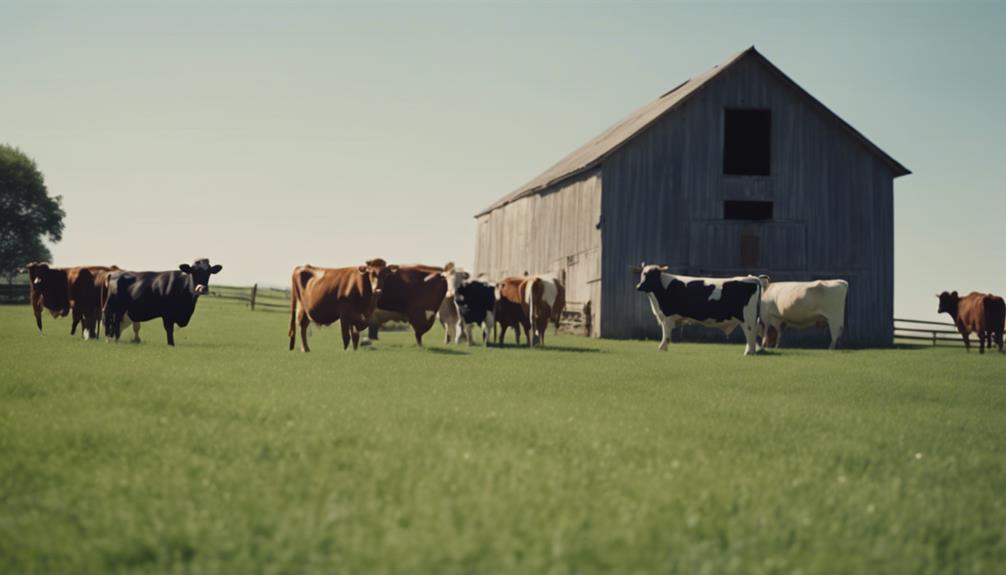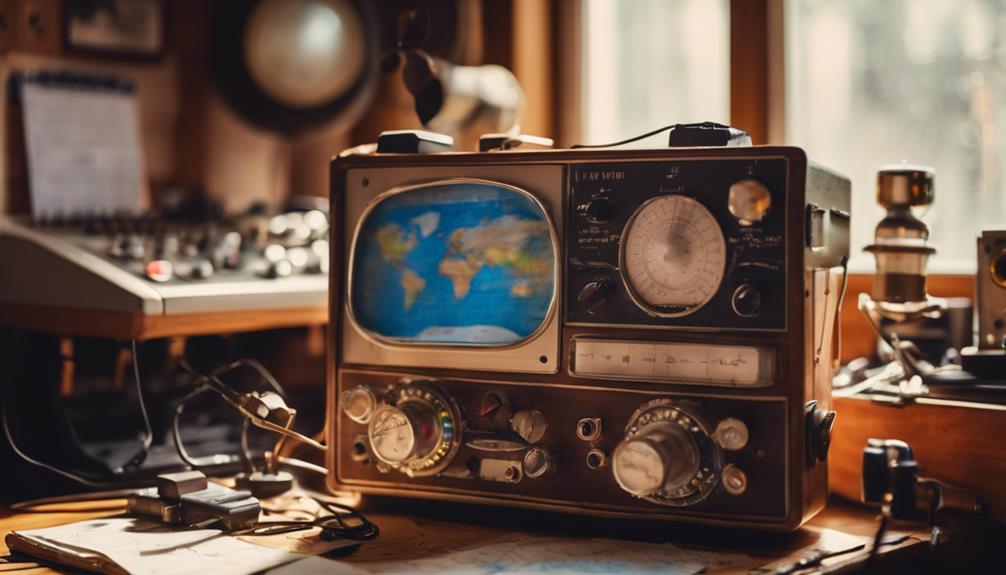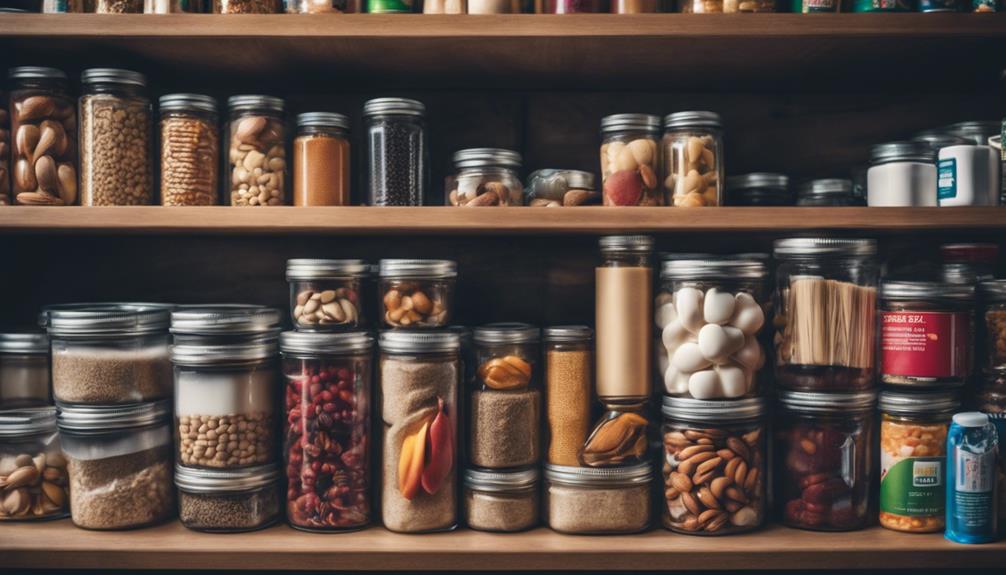Cattle are indispensable for survival homesteads, providing meat, milk, and labor. When selecting breeds, it's important to take into account personal needs and local climate adaptability. For meat production, breeds like Black Angus and Hereford thrive with minimal care, while dairy needs can be met with Holsteins or Jerseys, known for their high milk yield and quality. Hardy breeds guarantee better survival rates in unpredictable conditions. Proper feed management and emergency preparedness bolster resilience. Exploring these options further will reveal the best breeds to suit specific homestead goals and enhance overall self-sufficiency.
Key Takeaways
- Choose hardy beef breeds like Black Angus or Hereford for sustainable meat production and adaptability to various climates.
- For dairy needs, consider Holsteins for high milk yield or Jerseys for rich butterfat content and gentle temperament.
- Prioritize breeds that align with your specific goals, whether for meat, milk, or both, ensuring optimal resource use.
- Implement feed management techniques like crop rotation and stockpiling to secure resources during emergencies.
Importance of Cattle in Homesteading
Cattle play an essential role in homesteading by providing key resources such as meat, milk, and labor, making them invaluable for self-sufficiency and sustainability.
They're not just sources of food; they also contribute to the homestead's operational needs. Cattle can pull carts and farm equipment, reducing reliance on machinery. Their hides can be transformed into durable leather goods, while hooves and horns serve as tools. Additionally, internal organs can be used for various medicinal purposes.
Stockpiling feed is important, as a well-fed herd guarantees survival during crises. By maintaining a healthy cattle population, homesteaders secure their livelihoods, making cattle an integral part of sustainable living practices.
Types of Cattle for Survival
Selecting the right type of cattle for a survival homestead is essential for achieving self-sufficiency and resilience in various environments.
Homesteaders typically choose between beef and dairy cattle, depending on their specific needs. Beef cattle provide a sustainable source of meat, while dairy breeds offer milk and other dairy products.
It's imperative to select breeds that are adaptable to local climates and resilient against harsh conditions. Additionally, the size of the breed should align with available space and resources.
Focusing on hardy breeds guarantees better survival rates and productivity, making research into local breed performance fundamental.
Ultimately, aligning breed choice with individual goals, whether for meat or milk, is key for long-term success in a survival setting.
Recommended Meat Cattle Breeds

Which meat cattle breeds are best suited for survival homesteads?
Black and Red Angus tops the list due to their small size, hardiness, and polled trait, making them easy to manage.
Charolais stands out for its exceptional musculature, though they may need more care.
Hereford, characterized by its deep red color, offers a smaller frame and includes both polled and horned varieties.
Simmental cattle are large, boast excellent muscling, and finish quickly, while Limousin is known for its reddish-brown or black coat, good mothering abilities, and rapid calf growth.
Each breed brings unique advantages, so choosing the right one hinges on the homestead's specific needs and resources.
Top Dairy Cattle Breeds
For survival homesteads, several top dairy breeds can provide reliable milk production and adaptability to various climates.
The Holstein stands out with its tall stature and ability to produce 2-3 gallons of milk daily.
Jerseys, smaller in size, are prized for their high butterfat content and gentle temperament.
Brown Swiss is known for its resilience and larger size, making it suitable for diverse environments.
Guernsey cattle offer attractive coloration and commendable early milk production, while Ayrshires are recognized for their ruggedness and excellent udder health.
Each breed's unique traits contribute to a homesteader's dairy needs, ensuring a steady milk supply while thriving in different conditions.
Selecting the right breed can enhance both sustainability and productivity on the homestead.
Factors in Breed Selection

Evaluating breed characteristics is essential for determining the most suitable cattle for a survival homestead.
Potential owners should consider climate adaptability, as some breeds thrive in harsh conditions while others may struggle.
Size also plays a significant role; larger breeds require more space and resources, which mightn't be feasible for every homestead.
It's important to align breed selection with specific goals, whether that's meat production or dairy yield.
Hardy breeds, known for resilience, can offer better chances of survival in unpredictable situations.
Researching local breed performance allows homesteaders to make informed choices based on regional conditions and available resources, ensuring a sustainable and productive cattle operation.
Feed Management Techniques
Effective feed management techniques are essential for maintaining a healthy and productive cattle herd on a survival homestead. Implementing strategies like crop rotation and growing forage can enhance feed quality. Additionally, preserving feed through drying or fermenting extends its usability.
| Technique | Benefits | Tips |
|---|---|---|
| Crop Rotation | Improves soil health | Rotate crops annually |
| Drying | Extends feed shelf life | Utilize sunny days |
| Fermenting | Enhances nutritional value | Use airtight containers |
| Cover Crops | Increases nutrient availability | Plant in off-seasons |
| Stockpiling | Guarantees food security | Store in cool, dry places |
Emergency Preparedness for Cattle

Preparing for emergencies involves creating a robust plan for cattle that addresses potential food shortages, health risks, and environmental threats.
Homesteaders should stockpile feed to guarantee cattle have enough resources during crises, as prolonged disruptions can quickly deplete supplies.
Establishing connections with local farmers and veterinarians provides vital support and resources when needed.
Regular training on animal handling and emergency protocols is essential, enabling owners to respond effectively in urgent situations.
Monitoring weather patterns and potential threats helps anticipate challenges, allowing for timely interventions.
Additionally, maintaining a well-documented inventory of feed and medical supplies guarantees readiness.
Frequently Asked Questions
How Much Space Do I Need for Cattle on My Homestead?
When determining space for cattle, he considers factors like breed size, age, and purpose. Generally, he needs at least one acre per cow, ensuring enough room for grazing, shelter, and movement. Proper planning's essential for welfare.
What Are the Initial Costs of Starting a Cattle Herd?
Starting a cattle herd can feel like planting seeds of hope. Initial costs typically include purchasing animals, feed, fencing, and shelter. Smart budgeting guarantees a thriving future, but expenses can quickly add up without careful planning.
How Can I Prevent Diseases in My Cattle?
To prevent diseases in cattle, he guarantees regular vaccinations, maintains clean living conditions, provides balanced nutrition, monitors herd health, and practices good biosecurity measures. These steps help keep the cattle healthy and thriving.
What Is the Lifespan of Cattle in a Homesteading Environment?
In a homesteading environment, cattle generally live around 15 to 20 years. Proper care, nutrition, and regular veterinary check-ups can greatly extend their lifespan, ensuring healthy and productive lives for both beef and dairy breeds.
Can Cattle Be Kept With Other Livestock Species?
Cattle can coexist with other livestock species, provided they're managed properly. They'll benefit from companionship while minimizing stress. However, owners should monitor interactions to guarantee safety and prevent competition for resources among the animals.
Conclusion
In the journey of survival homesteading, choosing the right cattle breed isn't just important; it's the backbone of a resilient lifestyle.
With the right meat or dairy cattle, homesteaders can transform their land into a thriving food source. By carefully selecting breeds suited to their environment, homesteaders can maximize both sustainability and productivity on their farms. In addition to cattle, it’s crucial to have proper infrastructure and tools, as well as a basic knowledge of guinea homesteading essentials, which play a key role in maintaining smaller livestock like chickens and guinea fowl. With the right approach, a balanced and diverse homestead can provide food year-round, ensuring greater self-sufficiency.
As they nurture their herds, they're not just raising animals; they're cultivating sustainability, independence, and a connection to their land.
After all, in the domain of self-sufficiency, cattle aren't merely livestock—they're lifelines.










